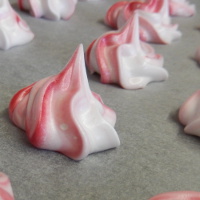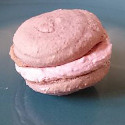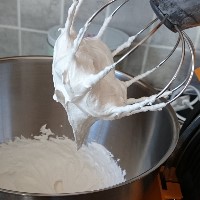
I have tried a few different egg substitutes. There is powdered egg replacer which can be bought from health-food shops, it works reasonably well in cookies. For cakes I have used 'flax-eggs' and 'chia-eggs' made by mixing the respective seeds with water until they turn gloopy. All of these are good for replacing the 'binding' properties of eggs. Aquafaba however is quite special... When I first came across it, I was literally hopping with excitement!
Aquafaba means 'bean-water'. It is the gloopy liquid that you get in a tin of chickpeas, or other canned beans. You'd normally tip it down the sink (I used to). But instead of throwing it away, put it in a bowl and whisk it. It turns into a foam with a consistency just like egg whites. This leads to lots of exciting options that were previously not possible when cooking without eggs: meringues, French macarons and even mayonnaise!
For further info, including the story about how aquafaba was discovered, see the aquafaba website.
For cutting edge recipes, see this facebook group. All of my aquafaba experiments have come from here.
A word of warning... Since aquafaba is made from the liquid surrounding tinned legumes, it is quite likely to be high FODMAP. Proceed with caution if you are following the low-FODMAP diet.

If you are keen to try out aquafaba I recommend you try this first. The recipe is from the Vegan Meringue facebook group:
The basic recipe for aquafaba meringues is aquafaba to sugar somewhere in between 1:2 and 2:1 ratio, with completely optional ingredients to help stiffen the peaks, like vinegar or cream of tartar. You then bake it between 80C/176F to 110C/230F, depending on your oven.
- Drain the liquid from one 400 g tin of chickpeas. You should get 1/2 to 3/4 cups (120-180 ml).
- Obtain about 1.33 times the volume of your liquid in sugar (eg caster sugar).
- Whip the liquid in a mixer until stiff peaks form. Don't worry, you can't really overwhip, and you need good whisk attachment and high speed.
- After you have your peaks, add the sugar, slowly, a tbsp at a time and incorporate it well each time.
- After all the sugar is incorporated, feel the foam and if it has any grittiness, keep whipping till it's gone.
- Then deposit or extrude it onto a dry, clean baking mat or parchment paper covered cookie sheet in 3cm/1.5 inch blobs, and bake at 100C/215F for 1.5 hours.
- After the time is up, crack the oven door, and let them cool to room temperature.
- Store the completed meringues in an airtight container to keep them from getting soft.

I absolutely love French Macarons, with their perfectly crispy outer shells and that deliciously chewy interior. One of the great things about macarons is that they’re naturally gluten-free because they’re made with almond flour instead of regular wheat flour. So if you’re avoiding gluten, you don’t even have to tweak the recipe!
Now, the cream filling in the middle is usually made with butter or other dairy ingredients, but luckily that's very easy to swap out for a dairy-free buttercream or even a ganache made with non-dairy milk. And the fact that they can now be made completely egg-free as well just makes me so happy! It really means more people can enjoy them, no matter what their dietary needs are.
That said, macarons do have a bit of a reputation for being tricky to make. They're meant to be smooth on the top and have those little 'feet' at the bottom. As you can see here, I definitely still need to practice a bit more to get them looking exactly right — but they still taste pretty good, so I’m not too worried!
If you’d like to give them a try yourself, you can find recipes and inspiration on the Floral Frosting blog.
